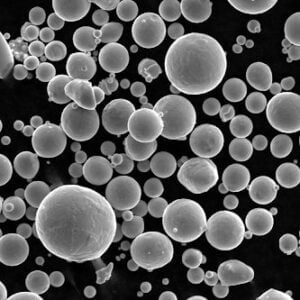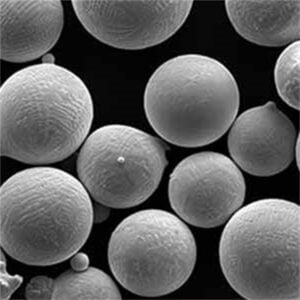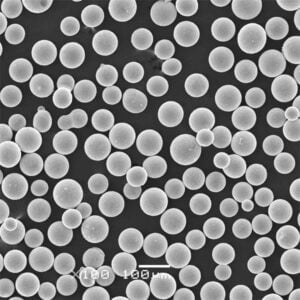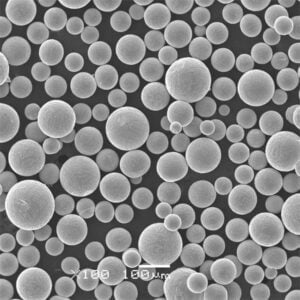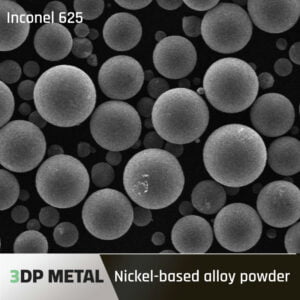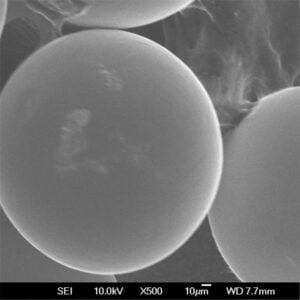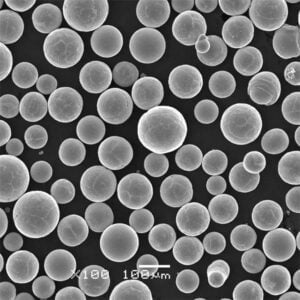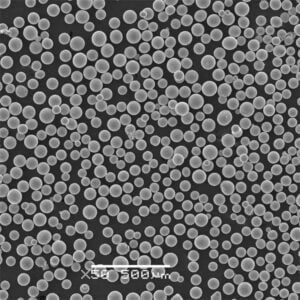Wolfram-Pulver hoher Dichte
Inhaltsübersicht
Wolframpulver mit hoher Dichte besitzt unter allen Metallpulvern die größte Dichte, da Wolfram eine außerordentlich hohe Eigendichte aufweist, die der von Gold nahe kommt. Diese einzigartige Eigenschaft ermöglicht die fortschrittliche Entwicklung kompakter, gewichtseffizienter Komponenten in verschiedenen Sektoren, die schwere Pulverpress- und Sinterverfahren nutzen.
Übersicht von Wolframpulver
Mit einer Dichte von 19,3 g/cm3 in fester Form bringt Wolfram ein enormes Gewicht in ein winziges Volumen. Aus diesem Grund bietet Wolframpulver in verdichteter Form eine unübertroffene Dichte, die mit keinem anderen Material erreicht werden kann. Teile aus hochdichtem Wolframpulver finden zahlreiche Anwendungen in anspruchsvollen Umgebungen.
Zu den wichtigsten Faktoren für die Verwendung von Wolframpulver mit hoher Dichte gehören:
- Hohe Dichte ähnlich wie bei Edelmetallen wie Gold und Platin
- Verdoppelt die verfügbare Dichte im Vergleich zu Blei, Stahl
- Ermöglicht schwere und dennoch kompakte Größen und Formen
- Einfacher pulvermetallurgischer Weg zum Endprodukt
- Anpassbare Eigenschaften durch Mischen von Legierungselementen
- Wiederverwertbarkeit von hochwertigem Wolfram
Anwendungen, die sich die Dichte zunutze machen, umfassen Vorschaltgeräte, Strahlungsabschirmung, Trägheit, Gewichtung von Verbundwerkstoffen, Schwingungsdämpfung und Miniaturisierung von Komponenten.
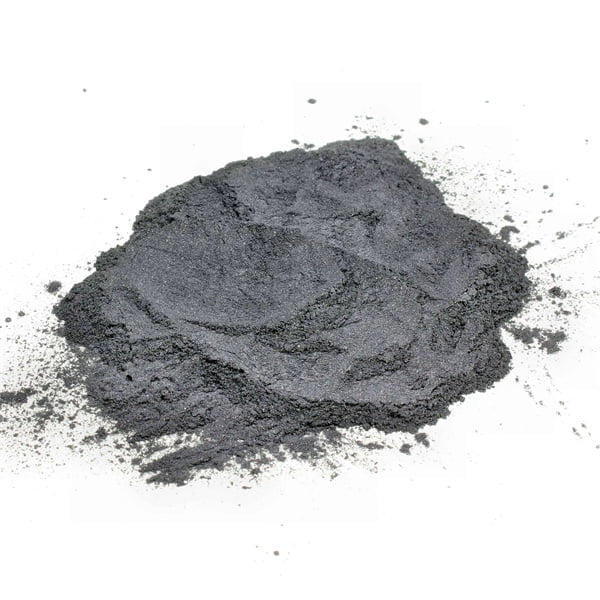
Arten von hochdichtem Wolframpulver
Zwar bieten alle Wolframpulversorten eine hohe Dichte, doch bestimmte Sorten und Zusammensetzungen weisen nach dem Formen und Sintern optimale Dichtewerte auf:
| Typ | Beschreibung | Typische Dichte |
|---|---|---|
| Reines Wolfram | Höhere Reinheit über 99,95% gewährleistet zuverlässige Dichte | ≥18 g/cm |
| Dotiertes Wolfram | Kleine Zusätze von Seltenerdoxiden wie Y2O3 verbessern die Sinterdichte | ≥18,5 g/cm |
| Wolfram-Nickel-Eisen | Ni-Fe-Legierung sorgt für hervorragende Enddichte | ≥18 g/cm |
| Schwere Wolframlegierungen | 90-97% W mit Ni-Cu-Fe-Bindephasen | ≥17,5 g/cm |
| Wolfram-Verbundwerkstoffe | Vermischt sich mit Gold, Tantal, abgereichertem Uran usw. | bis zu 21 g/cm |
Diese verbesserten Formulierungen erweitern die Hochleistungsoptionen über reines Wolfram hinaus auf maßgeschneiderte Eigenschaftskombinationen.
Zusammensetzung von Wolframpulver
Hochreines Wolframpulver, das für die höchstmögliche Dichte geeignet ist, enthält über 99,95% Wolfram mit nur geringen Restverunreinigungen:
| Element | Maximaler Inhalt | Rolle |
|---|---|---|
| Wolfram (W) | 99.95% | Hauptkomponente |
| Kohlenstoff (C) | 100 ppm | Hemmstoff für das Kornwachstum |
| Sauerstoff (O) | 100 ppm | Oberflächenoxid |
| Kupfer (Cu) | 10 ppm | Verbleibende Spurenverunreinigung |
| Kieselerde (Si) | 20 ppm | Verunreinigung |
Spezialisierte Schwermetalllegierungen haben gezielte Legierungszusätze wie Nickel, Kupfer, Eisen usw. zusammen mit Wolfram, um die Eigenschaften weiter zu verbessern.
Eigenschaften von Wolframpulver
Hochdichtes Wolframpulver ermöglicht die Herstellung von endkonturnahen Teilen mit extremer Dichte bei gleichzeitig guter Festigkeit, Härte und thermischen Eigenschaften.
Physikalische Eigenschaften
| Eigentum | Wert |
|---|---|
| Dichte | ≥18 g/cm3 |
| Schmelzpunkt | 3380-3410°C |
| Stärke | Bis zu 1000 MPa |
| Härte | ≥400 VPN |
| Wärmeleitfähigkeit | ∼175 W/(m-K) |
| Koeffizient der thermischen Ausdehnung | ∼4,5 μm/(m-K) |
Diese Eigenschaften ergeben sich aus der intrinsischen atomaren Struktur von Wolfram und machen es ideal für Anwendungen mit hoher Dichte, die thermisch-mechanische Integrität erfordern.
Mechanische Eigenschaften
Durch sorgfältiges Pressen und Sintern des Pulvers werden vorteilhafte mechanische Eigenschaften erzielt:
| Eigentum | Wert |
|---|---|
| Härte | Bis zu 550 VPN |
| Streckgrenze | ∼900 MPa |
| Zugfestigkeit | Bis zu 1000 MPa |
| Dehnung | ∼10% bis 15% |
| Bruchzähigkeit | ∼20 MPa√m |
| Ermüdungsfestigkeit | 500 MPa |
Legierungselemente wie Nickel, Eisen usw. tragen dazu bei, Duktilität, Zähigkeit und Bearbeitungseigenschaften anzupassen.
Physische Attribute
Wesentliche physikalische Eigenschaften von Wolframpulver hoher Dichte, die für Designer nützlich sind:
| Parameter | Wert | Einheit |
|---|---|---|
| Dichte | 18 bis 19,3 | g/cm3 |
| Elektrischer spezifischer Widerstand | 5.5 | μΩ-cm |
| Wärmeleitfähigkeit | 170 | W/(m-K) |
| Schmelzpunkt | 3410 | °C |
| Siedepunkt | 5930 | °C |
| Spezifische Wärme | 132 | J/(kg-K) |
Der ultrahohe Schmelzpunkt und die Wärmeleitfähigkeit gewährleisten die Beibehaltung der Festigkeit und Maßhaltigkeit bei extremen Temperaturen.
Produktion von Wolframpulver
| Bühne | Beschreibung | Wichtige Punkte |
|---|---|---|
| 1. Rohstoffbeschaffung | Der Prozess beginnt mit dem Abbau von Wolframerz, das hauptsächlich aus Wolframit und Scheelit besteht. | * Wolframerze kommen auf der ganzen Welt vor, zu den größten Produzenten zählen jedoch China, Peru und Bolivien. * Die Abbaumethoden variieren je nach Lagerstätte, gängige Techniken sind jedoch Tagebau und Untertagebau. * Das abgebaute Erz wird zerkleinert, gemahlen und konzentriert, um Verunreinigungen zu entfernen und den Wolframgehalt anzureichern. |
| 2. Chemische Verarbeitung | Das konzentrierte Erz wird dann in eine chemische Zwischenverbindung umgewandelt, die für die weitere Reinigung und Reduktion geeignet ist. | * Ammoniumparawolframat (APT) ist das am häufigsten verwendete Zwischenprodukt. Es wird durch eine Reihe chemischer Reaktionen hergestellt, die Auslaugung, Filtration und Niederschlag umfassen. * APT bietet Vorteile wie hohe Reinheit und gute Handhabungseigenschaften. * Je nach spezifischem Herstellungsverfahren können auch andere Zwischenverbindungen wie Wolframsäure oder Wolframoxide verwendet werden. |
| 3. Hochreine Oxidproduktion | Weitere Reinigungsschritte sorgen für die Entfernung verbleibender Verunreinigungen und erreichen den gewünschten Wolframoxidgehalt zur Reduktion. | * APT durchläuft zusätzliche Reinigungsschritte wie Rekristallisation oder Lösungsmittelextraktion, um die strengen Reinheitsanforderungen für die Wolframpulverproduktion zu erfüllen. * Wolframoxide wie WO3 (Wolframtrioxid) oder WO2 (Wolframdioxid) sind oft das Endprodukt dieser Phase. * Die Wahl des Oxids und seine spezifischen Eigenschaften können die endgültigen Eigenschaften des Wolframpulvers beeinflussen. |
| 4. Wasserstoffreduktion | Das gereinigte Wolframoxid wird dann mithilfe von Wasserstoffgas in einer kontrollierten Ofenumgebung zu metallischem Wolframpulver reduziert. | * Dieser Schritt ist das Herzstück der Wolframpulverproduktion. Wasserstoff wirkt als Reduktionsmittel, entzieht dem Wolframoxid Sauerstoff und hinterlässt reine Wolframmetallpartikel. * Der Reduktionsprozess erfolgt in Stoßöfen oder Drehrohröfen bei genau kontrollierten Temperaturen (typischerweise zwischen 600 °C und 1100 °C) und Wasserstoffgasdurchflussraten. * Eine sorgfältige Kontrolle dieser Parameter ist entscheidend, um die gewünschten Eigenschaften des Wolframpulvers wie Partikelgröße, Morphologie und Reinheit zu erreichen. |
| 5. Pulverklassifizierung und -veredelung | Das Rohwolframpulver aus dem Reduktionsofen wird weiterverarbeitet, um die endgültigen gewünschten Eigenschaften zu erreichen. | * Das Pulver wird gesiebt und klassifiziert, um spezifische Partikelgrößenverteilungen zu erhalten. Verschiedene Anwendungen erfordern Pulver mit unterschiedlichen Partikelgrößen und Morphologien. * Zusätzliche Prozesse wie Mahlen oder Granulieren können verwendet werden, um die Partikelgröße und -form weiter zu verfeinern. * Das Pulver kann auch Entgasungsbehandlungen unterzogen werden, um jeglichen Restwasserstoff aus dem Reduktionsprozess zu entfernen. |
| 6. Qualitätskontrolle | Während des gesamten Produktionsprozesses werden strenge Qualitätskontrollmaßnahmen durchgeführt, um sicherzustellen, dass das endgültige Wolframpulver alle erforderlichen Spezifikationen erfüllt. | * Durch chemische Analyse werden die elementare Zusammensetzung und Reinheit des Pulvers bestimmt. * Partikelgrößenverteilung und Morphologie werden mithilfe von Techniken wie Laserbeugung und Elektronenmikroskopie analysiert. * Weitere Tests können Eigenschaften wie Dichte, Fließfähigkeit und Sinterverhalten bewerten. * Die Aufrechterhaltung einer gleichbleibenden Qualität ist für die Leistung der aus dem Pulver hergestellten Wolframprodukte von entscheidender Bedeutung. |
Anwendungen von Wolframpulver
| Kategorie | Anmeldung | Immobilien gehebelt | Beispiele |
|---|---|---|---|
| Industrie & Fertigung | Bearbeitungs- und Schneidwerkzeuge | Extreme Härte, Verschleißfestigkeit | – Bohrer – Fräseinsätze – Schaftfräser – Drehwerkzeuge |
| Matrizen und Formen | Hoher Schmelzpunkt, thermische Stabilität | – Extrusionswerkzeuge für Drähte und Filamente – Heißprägewerkzeuge – Kunststoff-Spritzgusswerkzeuge | |
| Elektroden | Hoher Schmelzpunkt, gute elektrische Leitfähigkeit | – Schutzgasschweißelektroden (WIG) – Widerstandsschweißelektroden | |
| Glühfäden und Heizelemente | Hoher Schmelzpunkt, gute elektrische Leitfähigkeit | – Glühfäden für Glühbirnen – Heizelemente für Öfen | |
| Katalysatoren | Große Oberfläche, Fähigkeit, chemische Reaktionen zu fördern | – Katalysatoren für die Ammoniakproduktion – Katalysatoren für die Kohlenwasserstoffverarbeitung | |
| Pigmente und Beschichtungen | Hohe Dichte, Röntgenstrahlenundurchlässig | – Strahlenschutz für medizinische Geräte – Röntgenkontrastmittel | |
| Elektrotechnik und Elektronik | Elektrische Kontakte und Schalter | Hoher Schmelzpunkt, gute elektrische Leitfähigkeit, Lichtbogenbeständigkeit | – Relaiskontakte – Leistungsschalterkontakte – Hochspannungsschaltgerätekontakte |
| Wärmesenken | Hohe Wärmeleitfähigkeit | – Wärmeableitung elektronischer Komponenten | |
| Halbleiterfertigung | Hohe Dichte, Ätzbeständigkeit | – Wolfram-Plugs und Vias in integrierten Schaltkreisen – Gate-Elektroden in Transistoren | |
| Konsumgüter | Sportartikel (Golfschläger, Angelgewichte) | Hohe Dichte zur Gewichtsverteilung | – Golfschlägergewichtung für verbesserten Schwung – Angelgewichte für tieferes, schnelleres Sinken |
| Schwingungsdämpfung | Hohe Dichte | – Dämpfer in Tennisschlägern und Bogensportausrüstung – Schwingungsdämpfer in Maschinen | |
| Erweiterte Anwendungen | Additive Fertigung (3D-Druck) | Feine Partikelgröße, gute Fließfähigkeit | – 3D-gedruckte Komponenten für die Luft- und Raumfahrt- und Automobilindustrie – Medizinische Implantate |
| Kernenergie | Hoher Schmelzpunkt, Neutronenabsorption | – Steuerstäbe in Kernreaktoren – Abschirmung von Atommüll | |
| Militär & Verteidigung | Panzerbrechende Penetratoren | Hohe Dichte, extreme Härte |
Spezifikationen
Festlegung der wichtigsten Parameter für Wolframpulver mit hoher Dichte:
Qualitäten von Wolframpulver
| Klassenbezeichnung | Durchschnittliche Partikelgröße (Mikrometer) | Reinheit (mindestens % Wolfram) | Anwendungen |
|---|---|---|---|
| Ultrafeines Wolframpulver | < 1.0 | ≥ 99.95 | – Thermische Spritzbeschichtungen für Turbinenschaufeln und andere Anwendungen mit hohem Verschleiß aufgrund hervorragender Sinterfähigkeit und Fließfähigkeit. |
| 1.0 – 3.0 | ≥ 99.95 | – Diamantwerkzeuge mit überragender Verschleißfestigkeit und Schärfe zum Schneiden und Schleifen harter Materialien. | |
| 3.0 – 5.0 | ≥ 99.9 | – Elektronische Substrate mit minimalen Verunreinigungen für hohe elektrische Leitfähigkeit und thermische Stabilität in integrierten Schaltkreisen. | |
| Feines Wolframpulver | 5.0 – 10.0 | ≥ 99.5 | – Schneidwerkzeuge aus Hartmetall bieten ein ausgewogenes Verhältnis zwischen Härte, Zähigkeit und Bruchfestigkeit für die Bearbeitung verschiedener Materialien. |
| 10.0 – 15.0 | ≥ 99,0 | – Hochleistungs-Elektrokontakte, die einen hohen Schmelzpunkt, Lichtbogenfestigkeit und elektrische Leitfähigkeit in Leistungsschaltanwendungen erfordern. | |
| 15.0 – 22.0 | ≥ 98,5 | – Elektroden für das Wolfram-Inertgasschweißen (WIG) aufgrund ihrer Fähigkeit, einen stabilen Lichtbogen und konzentrierte Hitze zu erzeugen. | |
| Mittleres Wolframpulver | 22.0 – 32.0 | ≥ 98,0 | – Penetratoren und kinetische Energieprojektile nutzen die hohe Dichte von Wolfram für eine überlegene Panzerdurchdringung. |
| 32.0 – 45.0 | ≥ 97,0 | – Strahlenschutzmaterialien in medizinischen Geräten und Nuklearanlagen aufgrund der Fähigkeit von Wolfram, Röntgen- und Gammastrahlen zu absorbieren. | |
| Grobes Wolframpulver | 45.0 – 75.0 | ≥ 96,0 | – Ballastgewichte für Gegengewichte und Schwingungsdämpfer, die die hohe Dichte von Wolfram für kompakte Größe und Wirksamkeit nutzen. |
| > 75,0 | ≥ 95,0 | – Kugelstrahlmittel zur Oberflächenverfestigung von Metallkomponenten durch einen Kaltbearbeitungsprozess. |
Standards für Wolframpulver
| Eigentum | Beschreibung | Bedeutung | Typische Normen |
|---|---|---|---|
| Reinheit | Die Reinheit von Wolframpulver gibt den Gewichtsanteil des Wolframmetalls (W) im Pulver an. Verunreinigungen können die physikalischen und mechanischen Eigenschaften von Wolframprodukten erheblich beeinträchtigen. | Höhere Reinheit führt im Allgemeinen zu einer besseren Leistung bei Anwendungen, die auf Eigenschaften wie elektrische Leitfähigkeit, Schmelzpunkt und Festigkeit angewiesen sind. Eine extrem hohe Reinheit ist jedoch nicht immer notwendig oder kosteneffizient. | – Hohe Reinheit (99,9% W und höher): Wird für Elektronik, Filamente und Elektroden verwendet, bei denen eine ausgezeichnete elektrische Leitfähigkeit entscheidend ist. – Standardreinheit (99,5% W – 99,9% W): Geeignet für verschiedene Anwendungen wie Hartmetall-Schneidwerkzeuge, Kühlkörper und Strahlenschutz. – Geringere Reinheit (unter 99,5% W): Wird in einigen speziellen Anwendungen wie Kunststofffüllstoffen oder als Rohstoff für die weitere Reinigung verwendet. |
| Partikelgröße und -verteilung | Die Partikelgröße bezeichnet den durchschnittlichen Durchmesser einzelner Wolframpartikel im Pulver. Die Partikelgrößenverteilung beschreibt die Variation der Partikelgrößen innerhalb einer Pulverprobe. | Partikelgröße und -verteilung beeinflussen maßgeblich das Verarbeitungsverhalten und die Endeigenschaften von Wolframprodukten. Feinere Partikel bieten beispielsweise eine bessere Sinterbarkeit, sind aber möglicherweise schwieriger zu handhaben. | – Pulver in Mikrongröße (1 – 50 Mikron): Wird häufig für die Hartmetallproduktion, das thermische Spritzen und die additive Fertigung verwendet. – Submikronpulver (unter 1 Mikron): Wird in Anwendungen verwendet, die eine große Oberfläche erfordern, wie Katalysatoren und leitfähige Beschichtungen. – Nanopulver (unter 100 Nanometer): Aufstrebender Bereich mit potenziellen Anwendungen in der Elektronik und bei Verbundwerkstoffen. |
| Scheinbare Dichte | Die scheinbare Dichte gibt das Gewicht des Wolframpulvers pro Volumeneinheit unter Berücksichtigung der Zwischenräume zwischen den Partikeln an. Sie beeinflusst, wie viel Pulver in eine Form gepackt werden kann und wie hoch die endgültige Dichte des gesinterten Produkts ist. | Eine höhere scheinbare Dichte ermöglicht eine effizientere Nutzung des Pulvers und kann zu dichteren Endprodukten mit verbesserten mechanischen Eigenschaften führen. | – Pulver mit hoher Dichte (>10 g/cm³): Wird für Anwendungen verwendet, die eine hohe Festigkeit und Verschleißfestigkeit erfordern, wie etwa Hartmetallwerkzeuge. – Pulver mit Standarddichte (7 – 10 g/cm³): Wird häufig für verschiedene Anwendungen verwendet, bei denen ein Gleichgewicht zwischen Dichte und einfacher Verarbeitung erwünscht ist. – Pulver mit geringer Dichte (<7 g/cm³): Kann in Anwendungen verwendet werden, bei denen eine lockere Packung oder Fließfähigkeit wichtig ist, wie beispielsweise bei einigen thermischen Spritzverfahren. |
| Fließfähigkeit | Unter Fließfähigkeit versteht man die Leichtigkeit, mit der sich Wolframpulver bewegen und gießen lässt. Sie ist entscheidend für die effiziente Handhabung und Verarbeitung in verschiedenen Anwendungen. | Eine gute Fließfähigkeit gewährleistet eine reibungslose Pulverzufuhr in Maschinen und minimiert die Entmischung unterschiedlicher Partikelgrößen innerhalb des Pulvers. | – Frei fließende Pulver: Wird durch eine spezielle Partikelgrößenverteilung und Oberflächenbehandlungen erreicht, um die Wechselwirkungen zwischen Partikeln zu minimieren. – Zusatzstoffe: Kann verwendet werden, um die Fließfähigkeit durch Verringerung der Reibung zwischen Partikeln zu verbessern. |
| Morphologie | Unter Morphologie versteht man die Gestalt und Form einzelner Wolframpartikel. | Die Partikelmorphologie kann das Packungsverhalten, die Sintereigenschaften und die endgültige Mikrostruktur von Wolframprodukten beeinflussen. | – Sphärische Pulver: Bieten eine gute Packungsdichte und Fließfähigkeit. – Angular Powders: Kann beim Sintern ein stärker ineinandergreifendes Netzwerk bilden, was möglicherweise zu einer verbesserten Festigkeit führt. – Dendritische Pulver: Können für bestimmte Anwendungen verwendet werden, bei denen ihre Verzweigungsstruktur Vorteile bietet. |
| Sauerstoffgehalt | Der Sauerstoffgehalt gibt die Menge an Sauerstoff an, die im Wolframpulver, typischerweise in Form von Oxiden, vorhanden ist. Übermäßiger Sauerstoff kann die endgültigen Eigenschaften von Wolframprodukten beeinträchtigen. | – Um eine optimale Leistung zu gewährleisten, ist für die meisten Anwendungen im Allgemeinen ein niedriger Sauerstoffgehalt erwünscht. – Strenge Sauerstoffgrenzwerte werden oft für Hochleistungsanwendungen wie Elektronik und Filamente spezifiziert. | |
| Zapfstellendichte | Die Klopfdichte ist ein Maß für die Packungsdichte von Wolframpulver, die durch einen standardisierten Klopfprozess erreicht wird. Sie liefert ein indirektes Maß für die Fließfähigkeit und die scheinbare Dichte. | – Eine höhere Klopfdichte weist auf eine bessere Packungseffizienz hin und kann als Qualitätskontrollparameter verwendet werden. | – Industrienormen legen häufig Mindestanforderungen an die Schüttdichte verschiedener Wolframpulversorten fest. |
Preisgestaltung
Repräsentative Preise für Wolframpulver, das für Anwendungen mit hoher Dichte geeignet ist:
| Klasse | Preis |
|---|---|
| Ultrafeine | $800 bis $1200 pro kg |
| Submikron | $500 bis $900 pro kg |
| Fein | $100 bis $250 pro kg |
| Mittel | $50 bis $150 pro kg |
| Schwere Legierungen | $40 bis $100 pro kg |
Kleinere Partikelgrößen, höhere Reinheit, spezielle Dotierstoffe und geringere Mengen erhöhen die Kosten. Recyceltes Schrottpulver ist billiger.
Pro und Kontra
| Vorteile | Benachteiligungen |
|---|---|
| Unübertroffen hoher Schmelzpunkt: Wolframpulver weist den höchsten Schmelzpunkt aller Metalle auf und erreicht beeindruckende 3.422 °C (6.192 °F). Dank dieser außergewöhnlichen Eigenschaft eignet es sich hervorragend für Anwendungen, die extremen Temperaturen ausgesetzt sind, wie z. B. Ofenauskleidungen, Raketendüsen und Hitzeschilde für den Wiedereintritt von Raumfahrzeugen. | Kostspielige Investition: Die Gewinnung und Verarbeitung von Wolfram ist ein komplexer Prozess, der im Vergleich zu herkömmlichen Metallen höhere Kosten verursacht. Dies kann ein erhebliches Hindernis für Anwendungen darstellen, bei denen die Kosten eine wichtige Rolle spielen. |
| Überlegene Wärme- und Stromleitfähigkeit: Wolframpulver leitet Wärme und Strom hervorragend. Daher eignet es sich ideal für Anwendungen, die ein effizientes Wärmemanagement erfordern, wie Kühlkörper in der Elektronik oder elektrische Komponenten wie Glühfäden in Glühlampen und Schweißelektroden. | Dicht und anspruchsvoll: Die bemerkenswerte Dichte von Wolfram, eine direkte Folge seiner dichten Atomstruktur, wirkt sich auch auf seine Pulverform aus. Diese hohe Dichte kann bei der Verarbeitung zu Herausforderungen führen. Um Wolframpulver effektiv zu handhaben und zu formen, sind möglicherweise spezielle Techniken und Geräte erforderlich. |
| Außergewöhnliche Verschleiß- und Korrosionsbeständigkeit: Wolframpulver zeichnet sich durch hervorragende Verschleißfestigkeit und Korrosionsbeständigkeit aus. Dadurch eignet es sich ideal für Anwendungen, die außergewöhnliche Haltbarkeit in rauen Umgebungen erfordern, wie panzerbrechende Geschosse, Bohrer für harte Materialien und Komponenten in chemischen Verarbeitungsanlagen. | Mögliche Gesundheitsrisiken: Eingeatmetes Wolframpulver kann die Lunge reizen und möglicherweise zu gesundheitlichen Komplikationen führen. Strenge Sicherheitsvorschriften und ausreichende Belüftung sind bei der Arbeit mit Wolframpulver unerlässlich, um das Expositionsrisiko zu minimieren. |
| Maßgeschneidertes Legierungspotenzial: Wolframpulver bildet leicht Legierungen mit verschiedenen Metallen und verbessert deren Eigenschaften deutlich. Dies ermöglicht es Ingenieuren, maßgeschneiderte Materialien mit spezifischen Kombinationen aus Festigkeit, Härte und Hitzebeständigkeit für Anwendungen wie Hochleistungsschneidwerkzeuge und Triebwerkskomponenten zu entwickeln. | Begrenztes weltweites Angebot: Die Hauptquelle von Wolfram ist geografisch konzentriert, wobei China die weltweite Produktion dominiert. Dies kann zu Schwachstellen in der Lieferkette und potenziellen Preisschwankungen führen. |
| Biokompatible Anwendungen: Wolfram weist eine gute Biokompatibilität auf, wodurch sich seine Pulverform für bestimmte medizinische Anwendungen eignet. Beispielsweise können Wolframimplantate aufgrund ihrer außergewöhnlichen Festigkeit und Verschleißfestigkeit für Hüftgelenkersatz eingesetzt werden. | Spezialisierte Lieferanten: Aufgrund der einzigartigen Eigenschaften und potenziellen Sicherheitsbedenken von Wolframpulver ist die Beschaffung bei seriösen und erfahrenen Lieferanten unerlässlich. Diese Lieferanten liefern hochwertiges, gut charakterisiertes Pulver und bieten technischen Support, um eine sichere Handhabung und optimale Leistung in der gewünschten Anwendung zu gewährleisten. |
| Neue Anwendungen im 3D-Druck: Wolframpulver findet neue Anwendung im schnell wachsenden Bereich der additiven Fertigung, auch bekannt als 3D-Druck. Seine einzigartige Kombination von Eigenschaften macht es zum idealen Werkstoff für den Druck von Hochleistungsmetallteilen für die Luft- und Raumfahrt, die Automobilindustrie und die Medizintechnik. | Bedenken hinsichtlich Fälschungen: Der hohe Wert von Wolframpulver kann Hersteller gefälschter Produkte anlocken. Die Zusammenarbeit mit qualifizierten Lieferanten mit strengen Qualitätskontrollpraktiken trägt dazu bei, das Risiko minderwertiger oder verunreinigter Materialien zu minimieren. |
Anbieter
Zu den führenden Händlern und Herstellern, die weltweit Pulver aus Wolfram und Wolframlegierungen mit hoher Dichte liefern, gehören:
| Unternehmen | Standorte |
|---|---|
| Büffel-Wolfram | Vereinigte Staaten |
| Wolfram Company | Österreich |
| Plansee-Gruppe | Europa |
| Midwest-Wolfram | Vereinigte Staaten |
| Xiamen Wolfram | China |
| JX Nippon | Japan |
| Toshiba-Materialien | Japan |
| GTP-Schäfer | Deutschland |
Diese Unternehmen beliefern kommerzielle Märkte mit zuverlässigen Pulvern von Weltklasse.
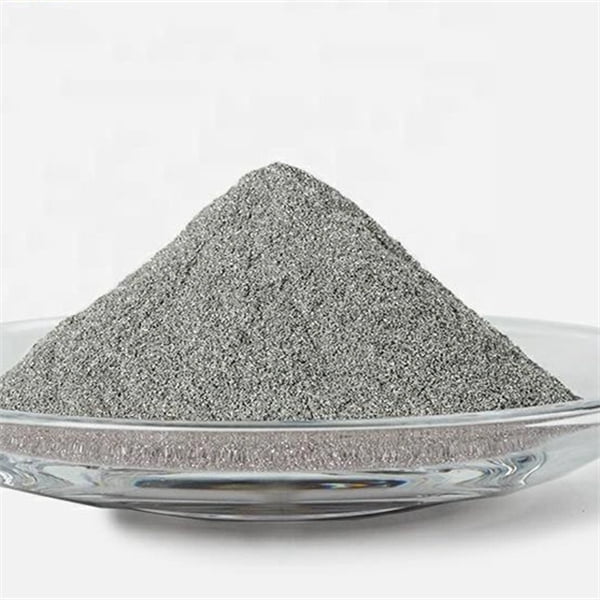
FAQs
| Frage | Antwort |
|---|---|
| Was ist Wolframpulver mit hoher Dichte? | Wolframpulver mit einer Dichte von 18 bis 19,3 g/cm3 - die höchste unter allen Metallpulvern |
| Wie wird Wolframpulver mit hoher Dichte hergestellt? | Reduktion von gereinigtem Wolframoxid kombiniert mit speziellem Mahlen für die gewünschte Partikelgröße |
| Wofür wird Wolframpulver hoher Dichte verwendet? | Herstellung von Gegengewichten, Strahlungsabschirmungen, Ballast, Beschwerungsmassen, schwingungsdämpfenden Bauteilen usw. |
| Was sind die verschiedenen Arten von Pulvern mit hoher Dichte? | Reines Wolfram, dotiertes Wolfram mit Seltenerdoxiden, Wolfram-Nickel-Eisen-Legierungen, Wolfram-Schwerlegierungen usw. |
| Was sind die Vorteile von Wolframpulver hoher Dichte? | Extreme Dichte in kompakten Volumina, die von anderen Pulvern nicht erreicht wird; Herstellung komplexer Teile in Nettoform möglich |
| Was sind die Einschränkungen bei der Verwendung von Wolframpulvern? | Relativ geringere Härte als Wolframkarbid; begrenzte Zähigkeit und Duktilität stellen eine Herausforderung für die Bearbeitung dar |
| Wie schneidet Wolframpulver mit hoher Dichte im Vergleich zu herkömmlichen dichten Materialien wie Blei ab? | Sicherer als giftiges Blei; höherer Schmelzpunkt als Blei; preislich günstiger als Edelmetalle mit ähnlicher Dichte |
Zusammenfassung
Mit seiner für elementare Metalle außergewöhnlichen Dichte bietet hochreines Wolframpulver den Konstrukteuren einzigartige Möglichkeiten für gewichtssensible Anwendungen, die kompakte Profile erfordern, die früher nicht möglich waren. Fortschritte bei der Pulverherstellung, dem Pressen, Sintern und der sekundären Verarbeitung überwinden die Grenzen der Sprödigkeit und ermöglichen einen breiteren Einsatz. Durch Mischen und Legieren lassen sich die physikalischen Eigenschaften in den anspruchsvollen Bereichen der Elektro-, Nuklear-, Automobil- und Luft- und Raumfahrtindustrie, in denen eine hohe Dichte mit Festigkeit, Härte und thermischer Beständigkeit einhergeht, noch besser anpassen.
Da nachhaltige Quellen zuverlässige globale Lieferketten unterstützen, nutzen Konstrukteure jetzt die extremen Dichten von Wolframpulver für die Feinmechanik in allen Branchen, in denen Schwere und Kompaktheit zusammen den Wert bestimmen. Führende Hersteller werden in den kommenden zehn Jahren versuchen, die Schwellenwerte für die Dichte von 20 g/cm3 zu überschreiten, da Wolfram eine größere strategische Bedeutung erlangt.
Teilen auf
MET3DP Technology Co., LTD ist ein führender Anbieter von additiven Fertigungslösungen mit Hauptsitz in Qingdao, China. Unser Unternehmen ist spezialisiert auf 3D-Druckgeräte und Hochleistungsmetallpulver für industrielle Anwendungen.
Fragen Sie an, um den besten Preis und eine maßgeschneiderte Lösung für Ihr Unternehmen zu erhalten!
Verwandte Artikel

Hochleistungs-Düsenschaufelsegmente: Revolutionierung der Turbineneffizienz mit 3D-Metalldruck
Mehr lesen "Über Met3DP
Aktuelles Update
Unser Produkt
KONTAKT US
Haben Sie Fragen? Senden Sie uns jetzt eine Nachricht! Wir werden Ihre Anfrage mit einem ganzen Team nach Erhalt Ihrer Nachricht bearbeiten.
Holen Sie sich Metal3DP's
Produkt-Broschüre
Erhalten Sie die neuesten Produkte und Preislisten

Metallpulver für 3D-Druck und additive Fertigung
UNTERNEHMEN
PRODUKT
cONTACT INFO
- Qingdao Stadt, Shandong, China
- [email protected]
- [email protected]
- +86 19116340731






